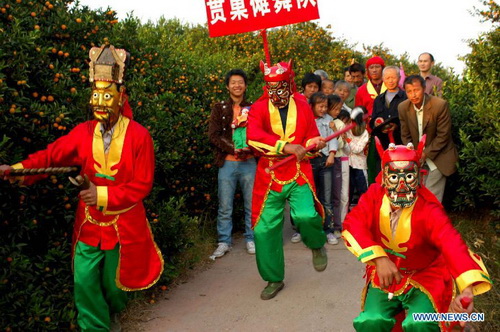Lofty Lushan Mountain
Temples in Hidden Places
On the First of August
Wheels by the Water
Share your travel story with regional@chinadaily.com.cn
Pioneer in mask making of Nuo dance
( English.news.cn )
Updated: 2012-07-12
 |
|
Villagers wearing Nuo masks made by Zhang Yixiang, a Chinese folk mask maker, dance to celebrate the harvest at Guanchao Village of Nanfeng County, east China's Jiangxi Province, in this file photo taken on Nov. 9, 2007. The 63-year-old Zhang Yixiang is the pioneer in mask making of Nuo dance. With gifted talents and dozens of years of hard work, Zhang created a large number of Nuo masks and gained reputation worldwide. In 1995, he was granted the title of "Civil Craft Artist" by UNESCO. Zhang has been fond of drawing and clay making since childhood. Such habits turned into his life-long pursuit and paved the way for his acquaintance with Nuo mask making as he grew up. Zhang was first employed by Tangjiake Village to make Nuo masks. But he couldn't remember the appearance of the masks as he only saw them when he was a child. When the time he learned that there were several old Nuo masks kept in another village, he asked friends to take him to have a look. After he returned home, he drew drafts of all the 25 masks according to his memories. On the lunar New Year's day in 1988, the 25 Nuo masks from Tangjiake Village were presented to the public. The mask maker, Zhang Yixiang, built his reputation ever since. Zhang has traveled more than 20 villages in Nanfeng County and nearby counties in Jiangxi and Fujian provinces and created thousands of Nuo masks over the years. Some of his works were inspired by the classic Chinese novels like "A Pilgrimage to the West" and "Canonization of the Gods". As the core prop in Nuo dance, Nuo mask has a history of over 2,000 years. Instead of a whole face, the mask for Nuo dance is made up of only a forehead and mouth. Residents in parts of Jiangxi and Guizhou provinces celebrate the Spring Festival by performing the ancient "Nuo" ritual dance. Dancers adorn themselves with red jackets, ghost-like masks and artificial tusks to mark the arrival of the Chinese lunar New Year. Villagers believe that the thousand-year-old dance will expel evil spirits, as well as bring mild weather and good harvests. (Xinhua/Song Zhenping) |




